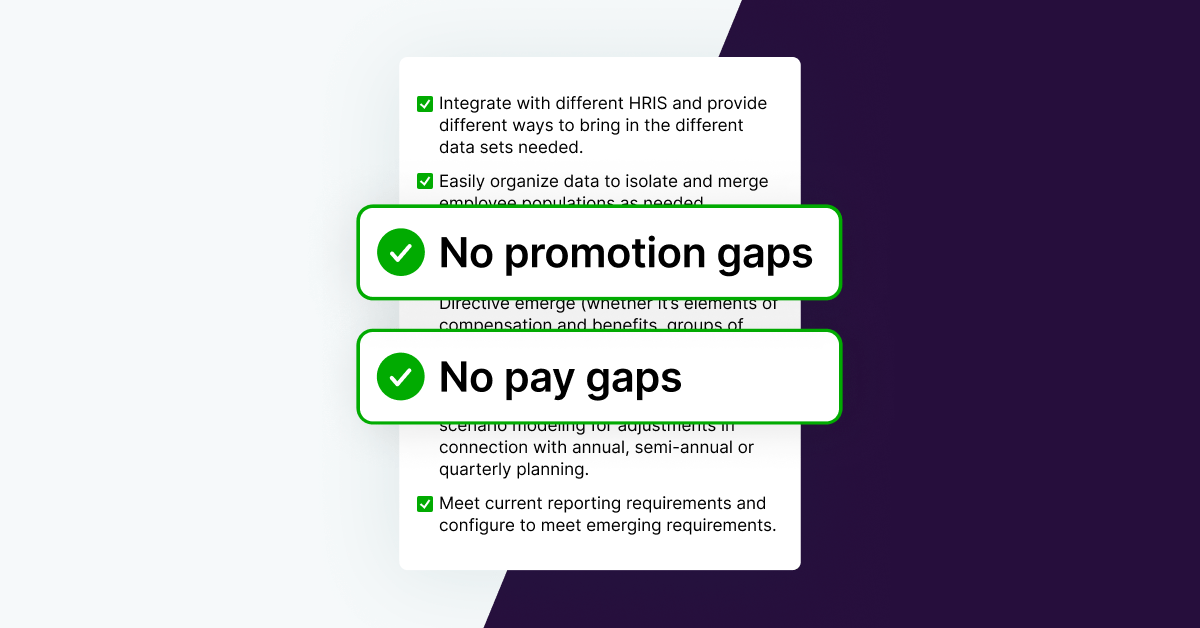Workplace equity is a transformative journey that demands investments in data analytics, technology, policy and process changes, cross-functional collaboration, and effective reporting and communication. It’s understandable that companies are keen to understand the tangible benefits and return on investment (ROI) of these efforts, especially as they batten down the hatches to prepare to weather a potential economic downturn.
To demonstrate the real-world benefits of workplace equity and why investing in it is more important than ever amidst today’s business pressures, we interviewed business leaders at American Airlines, Indeed, and Moderna, as well as workplace innovators, tech investors, and pay equity pioneers. Their stories reveal the benefits of their equity initiatives, showcasing how workplace equity builds trust, helps attract talent, boosts your employer brand, and fosters long-term success.
Don’t miss their top soundbites and takeaways below — then watch their full video stories to hear more!
1. Workplace equity can boost the credibility of your brand identity.
“With a constantly changing landscape, we really wanted to make sure we had the right tools to look at real-time data when it came to pay equity. And that allows us to make really insightful business decisions to ensure that we are continuing to maintain the trust and credibility with our employee base.”
– Courtney McMillian, VP of Total Rewards, Indeed
In this video, Indeed’s VP of Total Rewards Courtney McMillian highlights the importance of incorporating workplace equity into every aspect of the employee lifecycle, and of tying workplace equity to your company’s brand and values. Indeed’s mission to lower barriers to career opportunities for everyone is reflected in their commitment to fairness and pay equity. She shared that maintaining trust with employees in a constantly changing landscape requires real-time data and the right tools to meet the moment.
Ultimately, aligning your workplace equity efforts with your brand identity can lead to greater credibility with employees, as they know their company is truly committed to doing the right thing for everyone.
2. CEO buy-in can change the game — and pay off in talent acquisition and employer accolades.
“When Marc Benioff, our CEO, decided that equal pay was going to be part of our equality initiative, our values, part of our culture, it really opened the doors for us to do more. And when the CEO starts to ingrain that into the culture, then it shifts behavior, and it’s a top-down message. So what I saw was, automatically, when it’s priority for the CEO, it’s priority for other leaders as well.”
– Cindy Guerra Robbins, Board Member, Advisor, and Former President and Chief People Officer of Salesforce
How did the CEO of Salesforce wind up on 60 Minutes talking about pay equity? Hear the inside story from the leader who made it happen — Cindy Guerra Robbins. In 2013, Cindy led a study that motivated CEO Marc Benioff to rebalance gender pay across the company, generating acclaim for Salesforce as an equal-pay pioneer, one of the world’s most admired companies, and a widely-recognized “best place to work”.
In this video, Cindy discusses the power of getting CEO buy-in for workplace equity initiatives. When HR started reporting directly to Marc Benioff, Robbins saw an opportunity to address some of the challenges facing women in the company related to advancement, fair opportunities, maternity leave, and pay equity. By getting buy-in from the top down and involving other women executives in the conversation, Cindy was able to make significant progress.
Since then, Salesforce has continued to recognize pay equity as both a long-term investment that improves over time, and an employer brand strategy that has helped the company win numerous employer accolades and drive its talent goals. As Marc Benioff, Salesforce’s CEO, wrote in his book Trailblazer, Salesforce’s commitment to pay equity has already paid off in “incalculable ways” and “will continue to accrue for years.” He acknowledged that “Equalizing pay wasn’t an easy process, or a cheap one… [but] it has contributed to our ability to attract the very best and brightest talent in the country.”
The takeaway? When workplace equity becomes a priority for the CEO, it cascades throughout the organization, shifting behavior and driving meaningful results.
3. Transparency around your workplace equity progress can be a powerful branding tool.
“It’s not easy for companies to just start talking about pay equity… The Fair Pay Workplace certification allowed us to talk about what we’re doing, talk about the approach that we take… And we’ve also used our disclosures to talk about our [pay equity] journey, what we’re doing in this space.”
– Kim Wicker, VP of Executive Compensation, American Airlines
In this video, Kim Wicker, VP of Executive Compensation at American Airlines, shares how they’ve turned workplace equity into a brand advantage since they first started their journey in 2016 by signing the White House Pay Pledge.
Through regular analyses powered by Syndio’s pay equity solution — which allowed them to refine their methodology and dig into their own data — American Airlines has been able to make significant progress in the area of pay equity. Next they pursued third-party certification through Fair Pay Workplace, which empowered them to embrace pay transparency and talk about their pay equity practices and results more openly, even incorporating it into their ESG report each year.
As Kim’s story shows, companies can use their progress on workplace equity as a powerful branding tool, especially by being transparent and open about their journey.
4. Workplace equity directly impacts the entire employee experience.
“Workplace equity looks at everything you’re doing to create an ideal employee experience so that that experience gives the organization what it needs to be the most successful.”
– Scott Cawood, CEO, WorldatWork
In this video, Scott Cawood, CEO of WorldatWork, discusses the importance of workplace equity in creating the ideal employee experience and achieving organizational goals. He suggests that companies need to look beyond pay and examine the entire employee lifecycle, from hiring to promotions, and every opportunity in between, to ensure that they are creating an equitable experience for all their employees. This means measuring outputs and constantly refining the workplace equity approach against organizational goals.
Scott emphasizes that workplace equity is about creating a strong employee experience, one that values all employees regardless of their personal attributes.
5. Pay equity and pay transparency can be leveraged as a talent acquisition differentiator.
“We try and arm our Talent Acquisition team with as many of the tools as we can. One of those tools is… the ability to say ‘We pay fairly. We’ve done the study, we know we pay fairly, and we will continue to do that because it’s part of who we are.”
– Hem Patel, VP of Total Rewards, Moderna
Moderna has quadrupled in size over the past three years, making talent acquisition a critical priority for the company. In this video, Hem Patel, VP of Total Rewards at Moderna, discusses how they leverage their compensation and benefits package and pay equity as a differentiator for attracting and hiring talent.
Moderna also uses transparency around their compensation programs to reinforce their company mindset of “behaving like an owner,” demonstrating the potential upside of joining their team and contributing to the company’s mission of having a positive impact on patients.
The key takeaway from Hem is that pay equity can be a powerful tool for attracting top talent, particularly when it is combined with a culture that emphasizes transparency and employee ownership.
6. Investing in equity tech can provide returns in both business performance and retention.
“If you create an environment that people feel is fair and equal, that’s a recipe for success. Leaders can measure the impact of their equity and tech investment and their ROI in two distinct ways: [First], looking at the net benefit in terms of the profitability of the business and the productivity of the business. … [Second], creating a culture and an environment that an employee can thrive in…[with] transparency and an equal playing field.”
– Ryan Nece, Managing Partner of Next Legacy Capital
In this video, Ryan Nece, tech investor and Managing Partner of Next Legacy Capital, discusses why investing in equity tech is crucial for business success. Creating a fair and equal environment is key to attracting and retaining top talent, and investing in equity tech is both the right thing to do and a smart business move. Measuring the ROI of equity tech investments is both “a science and an art,” — the science is looking at the impact on business performance and the art is creating an equitable culture where employees can thrive (as measured by retention).
Ryan’s main point is that prioritizing workplace equity and investing in equity tech to modernize your approach is not only the right thing to do but also a smart business move that can help attract and retain top talent, improve productivity, and lead to long-term success.
Workplace equity pays off
Go check out the full video series for more insights into how aligning equity efforts with your brand pays off, why using technology for data analysis is a game-changer, and how transparency and certifications build trust. Investing in workplace equity is not just the right thing to do—it’s a smart business move that creates a vibrant and inclusive work environment where everyone can shine.
And that’s not all! You can also access our new Workplace Equity 101 video course, where Syndio experts share how to to unleash the power of your data to tell a compelling story of workplace equity progress — one step at a time.
The information provided herein does not, and is not intended to, constitute legal advice. All information, content, and materials are provided for general informational purposes only. The links to third-party or government websites are offered for the convenience of the reader; Syndio is not responsible for the contents on linked pages.


